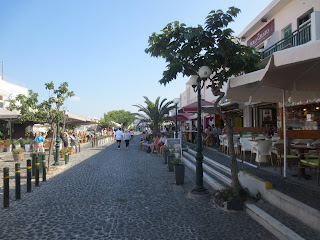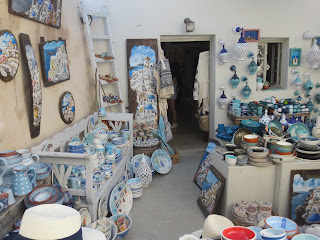I spent 3 days in Santorini in June 2019, with my wife and 4 year old son. We took a ferry from Athens, which took around 5 hours for the 200 km journey, though the Aegean Airlines flight back to Athens took barely 45 minutes. The ferry, named the Tera Jet, was gigantic and had the capacity to take 2,000 people and 500 cars! We got upgraded to first class, because the ferry wasn't full, so we traveled in real comfort. It was a relaxed, stress free time for us on this beautiful island, and it gave us a break from the beautiful but hectic history lessons during the rest of our trip!
Santorini is a Greek island in the Aegean Sea. Thera is the island’s official name. The island has a total population of 15,000 inhabitants and covers an area of 73 sq km, though if one adds the other smaller islands that form a part of it, the total area is about 90 sq km. In about 1600 BC, the island experienced a large volcanic eruption, which left a large caldera surrounded by volcanic ash deposits. The stunning caldera is the biggest reason behind Santorini's limitless charm.
 |
| View of the town of Fira, with the caldera and the Aegean Sea below |
Fira and Oia are the two most popular towns in Santorini, with their pretty white-washed buildings, and numerous churches, restaurants and shops. Both towns lie up on hills rising way above the caldera and the sea. Akrotiri is also a well known place that most travelers visit, though we missed it because it is at the island's southernmost tip, a bit far from where we were. It is an archaeological site, and excavations have shown traces of the Minoan civilization. Fragments of wall paintings and frescoes have been found in Akrotiri and are now housed in various museums, including the National Archaeological Museum in Athens.
In 1956, Santorini experienced a major earthquake, resulting in the destruction of many villages. In subsequent decades, because of the island's stunning natural beauty, it went on to become very popular with tourists, and today it is one of the world’s top islands for tourists.
We stayed at a place called Soulis Apartment, which was in
Cape Columbo towards the northern end of the island. It was a beautiful property, with an outdoor pool, a restaurant, very good service levels and its very own little church! The only challenge was that it was isolated, with no public transport available. The property did, however, have a shuttle bus to and from Fira twice a day. Given that it was very sunny and hot, we would take the 4:30 pm shuttle into Fira every day, and return by the 9 pm shuttle from Fira. That gave us enough time, because Fira was just 10 minutes away, and there was light outside till past 8:30 pm. Fira was connected by bus to the rest of the island. We would also go for morning walks along the rocky beaches of Cape Columbo. We would spend the late mornings and early afternoons in our apartment, just lazing, swimming, eating and watching movies on Netflix!
 |
| Soulis Apartment |
 |
| Gia Sas, an eatery along the rocky beach at Cape Columbo |
Fira is
the capital and largest town of Santorini. Fira is a town with
white-washed buildings and it lies on a 400 meter high hill in the western
side of Santorini. The
town centre, which is in the vicinity of the Main Square, is pedestrianized, with cobble stone
streets. There are numerous restaurants, shops and souvenir stores all over Fira, and it is a
charming little town. Fira also has several
churches, and a couple of interesting museums.
 |
| Main Square |
The Cathedral
Church of Candlemas of the Lord is also called the Fira Orthodox
Metropolitan Cathedral.
It is the town’s main orthodox church.
 |
| Cathedral Church of Candlemas of the Lord |
 |
| Interior, Cathedral Church of Candlemas of the Lord |
Church of St Minas is another one of Fira's prominent churches. It lies further down the hill, not far from Cathedral Church of Candlemas of the Lord.
 |
| Church of St Minas |
The Cathedral
Church of St John the Baptist is
the town’s main catholic church, in the catholic quarter. It was built in 1823 but was restored in 1970
after the 1956 earthquake. It is a baroque church with a rich interior.
 |
| Catholic Cathedral of St John the Baptist |
 |
| Interior, Catholic Church of St John the Baptist |
There are two ways of going from the town of Fira to the Old Port
below. Either one goes by cable car, or one goes along the pathway, where
riding on donkey back is an option. Near the Old Port, there is a Donkey
Station, popular with tourists.
 |
| View of the Old Port from the town |
 |
| Boats docked at the Old Port |
 |
| Donkey Station near the Old Port |
 |
| Donkeys going up the path to the town |
We were happy spending hours just roaming around the streets of Fira, looking at souvenir shops, eating at restaurants, watching the street performers playing music and generally soaking in the vibrant atmosphere.
 |
| Souvenir plates at a store |
 |
| Souvenir Bags at a store |
 |
Moussaka (a local lasagna with meat and eggplant),
at a Greek restaurant by the Old Port |
Oia is
a small but popular town at the northern end of Santorini. Oia is famous for its
many blue domed churches (including the much photographed Anastasi Church), set in the middle of white-washed buildings. The town lies
along the caldera at the northern edge of Santorini at
a height of 70 to 100 meters above sea level. Oia is full of restaurants and
shops, and like Fira, is a vibrant town where one can easily spend hours just walking around and admiring the delightful sights and sounds.
 |
| A view of Oia, with the Anastasi Church |
 |
| Ekklisia Agios Onoufrios |
 |
| Panagia Agion Panton |
 |
| A souvenir store in the heart of Oia |
Wow! That's the word that comes out when I think about our time in Santorini. For me, the things that stick in the mind are the buzzing little towns of Fira and Oia, the beautiful deep blue colour of the Aegean Sea, the stunning views of the breathtaking caldera, the delicious Greek cuisines, and the friendly people.




















No comments:
Post a Comment